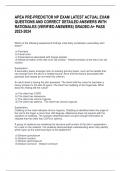Exam (elaborations)
APEA PRE-PREDICTOR NP EXAM LATEST ACTUAL EXAM QUESTIONS
- Course
- Institution
APEA PRE-PREDICTOR NP EXAM LATEST ACTUAL EXAM QUESTIONS AND CORRECT DETAILED ANSWERS WITH RATIONALES (VERIFIED ANSWERS) GRADED A+ PASS Which of the following assessment findings most likely constitutes a secondary skin lesion? a) Psoriasis b) Facial acne c) Facial lesions associated w...
[Show more]



